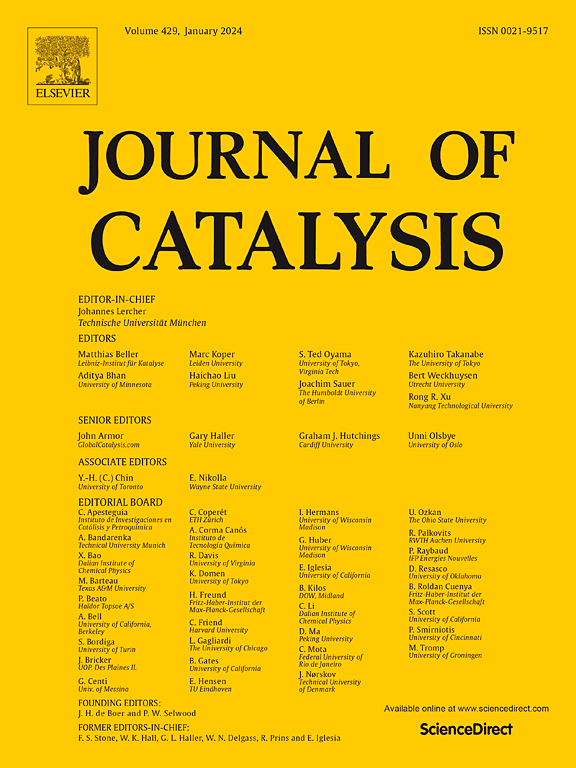甲烷干重整中Ni催化剂的MXenes性能研究
IF 6.5
1区 化学
Q2 CHEMISTRY, PHYSICAL
引用次数: 0
摘要
开发甲烷干重整(DRM)用抗焦催化剂是实现可持续合成气生产的关键。为了抑制结焦,本研究研究了在DRM中使用Ti3C2Tx和Nb2CTx MXenes作为Ni催化剂的载体,并与传统催化剂(Ni/γ-Al2O3, Ni/MgAl2O4和Ni/SiO2)进行了性能对比。用NH4HF2蚀刻MXenes,通过湿浸渍合成获得了10 wt%的Ni负载。Ni/Nb2CTx的H2消耗量最高(10.4 mmol /gcat)。DRM在700 °C下进行,CH4/CO2进料比为1:1,空速高(90,000 ml/gcat hr)。与其他催化剂不同,在500 °C下预还原的Ni/Nb2CTx表现出较低的正化焦化速率(4.41µgcoke/mmolCH4),较高的总反应速率(104 ± 13 mmol/gNi.min),最高的周转率为16.7 s−1。在这些条件下CO2的表观反应速率与CH4的反应速率相似,说明较低的焦化速率是由于解离氧的有效利用。在700 °C和大气压下对NbC(1 1 1)和TiC(1 1 1)表面进行的分子动力学(MD)模拟表明,快速的氧溢出介导了高效利用。模拟得到的平均氧速度在NbC (0.0969 Å/fs)上略高于在TiC (0.0961 Å/fs)上。两种MXene载体在DRM过程中都转化为稳定的碳化物,Nb2CTx在50 h TOS内稳定。这项研究不仅突出了Ni/Nb2CTx作为抗焦炭和抗烧结催化剂的潜力,而且还证明了MXenes载体在DRM过程中的作用。本文章由计算机程序翻译,如有差异,请以英文原文为准。


Exploiting MXenes properties for coking resistance of Ni catalyst in dry reforming of methane
The development of coke-resistant catalysts for dry reforming of methane (DRM) is critical for sustainable syngas production. To suppress coking, this study investigates the use of Ti3C2Tx and Nb2CTx MXenes as support for Ni catalysts in DRM and benchmarked their performance with conventional catalysts (Ni/γ-Al2O3, Ni/MgAl2O4, and Ni/SiO2). The MXenes were etched using NH4HF2, and a 10 wt% Ni loading on the supports was achieved via wet impregnation synthesis. Ni/Nb2CTx showed the highest H2 consumption (10.4 mmolH2/gcat). DRM was conducted at 700 °C using a feed ratio of CH4/CO2 of 1:1 and a high space velocity (90,000 ml/gcat h). Unlike the other catalysts, Ni/Nb2CTx pre-reduced at 500 °C exhibited a low normalized coking rate (4.41 µgcoke/mmolCH4), a high overall reaction rate (104 ± 13 mmol/gNi.min), and the highest turnover frequency at 16.7 s−1. The apparent CO2 reaction rate at these conditions was similar to the CH4 rate, suggesting that the low coking rate was due to the efficient utilization of dissociated oxygen. Molecular dynamics (MD) simulations performed on NbC(111) and TiC(111) surfaces at 700 °C and atmospheric pressure reveal that the efficient utilization was mediated by rapid oxygen spillover. The average oxygen velocity from the simulations was slightly higher on NbC (0.0969 Å/fs) than on TiC (0.0961 Å/fs). Both MXene supports are transformed to stable oxycarbides during DRM, and Nb2CTx was stable for 50 h TOS. This investigation not only highlights the potential of Ni/Nb2CTx as a coke- and sintering-resistant catalyst but also demonstrates the role of MXenes supports in the DRM process.
求助全文
通过发布文献求助,成功后即可免费获取论文全文。
去求助
来源期刊

Journal of Catalysis
工程技术-工程:化工
CiteScore
12.30
自引率
5.50%
发文量
447
审稿时长
31 days
期刊介绍:
The Journal of Catalysis publishes scholarly articles on both heterogeneous and homogeneous catalysis, covering a wide range of chemical transformations. These include various types of catalysis, such as those mediated by photons, plasmons, and electrons. The focus of the studies is to understand the relationship between catalytic function and the underlying chemical properties of surfaces and metal complexes.
The articles in the journal offer innovative concepts and explore the synthesis and kinetics of inorganic solids and homogeneous complexes. Furthermore, they discuss spectroscopic techniques for characterizing catalysts, investigate the interaction of probes and reacting species with catalysts, and employ theoretical methods.
The research presented in the journal should have direct relevance to the field of catalytic processes, addressing either fundamental aspects or applications of catalysis.
 求助内容:
求助内容: 应助结果提醒方式:
应助结果提醒方式:


